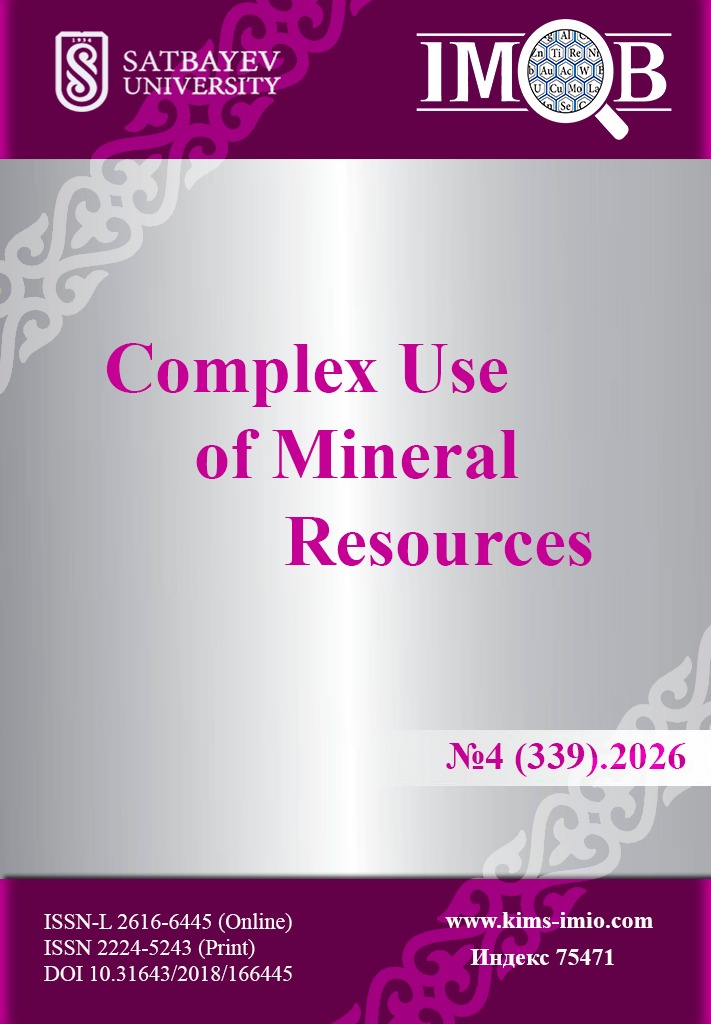Review of Sustainable Jet Fuel Production through Pyrolysis of Waste Tires: Process, The Physicochemical Properties and Catalyst
DOI:
https://doi.org/10.31643/2026/6445.40Keywords:
Catalyst, Jet fuel, Physicochemical Properties, Pyrolysis oil, Waste tires.Abstract
Solid waste, including waste tires, contributes significantly to global environmental pollution, with approximately one billion used tires generated annually. The use of waste tires as a source of sustainable aviation fuel (SAF) has the advantage of not competing with food sources, thus supporting energy needs without sacrificing food security. However, the production of jet fuel from waste tire pyrolysis oil faces major challenges to meet stringent American Society for Testing and Materials (ASTM) quality standards. This article reviews the physicochemical properties of waste tire pyrolysis oil, including viscosity, density, and sulfur content, and compares them with ASTM jet fuel specifications. A bibliometric analysis is carried out on the development of fuel research from waste tires being converted to jet fuel by collecting the number of papers and documents, the number of citations, and the countries that produce the most papers related to waste tires and their research. The development of catalysts for jet fuel production in the cracking process was also discussed in detail. The use of waste tire pyrolysis oil in jet engines was also reviewed as an initial step towards implementing sustainable fuels in the aviation sector.
Downloads
References
Emmanouilidou E, et al. Solid waste biomass as a potential feedstock for producing sustainable aviation fuel: A systematic review. Renewable Energy. 2023; 206:897-907. https://doi.org/10.1016/j.renene.2023.02.113
Jadav K, et al. Investigation of nano catalyst to enhance fuel quality in waste tyre pyrolysis. Energy Sources, Part A: Recovery, Utilization and Environmental Effects. 2022; 44(1):1468-1477. https://doi.org/10.1080/15567036.2019.1645245
Valentini F, and Pegoretti A. End-of-life options of tyres. A review. Advanced Industrial and Engineering Polymer Research. 2022; 5(4):203-213. https://doi.org/10.1016/j.aiepr.2022.08.006
Hoang AT, NguyenTH, and Nguyen HP. Scrap tire pyrolysis as a potential strategy for waste management pathway: a review. Energy Sources, Part A: Recovery, Utilization, and Environmental Effects. 2020; 46(1):6305-6322. DOI: https://doi.org/10.1080/15567036.2020.1745336
Xu J, et al. High-value utilization of waste tires: A review with focus on modified carbon black from pyrolysis. Sci Total Environ. 2020; 742:140235. https://doi.org/10.1016/j.scitotenv.2020.140235
Dabic-Miletic S, Simic V, and Karagoz S. End-of-life tire management: a critical review. Environ Sci Pollut Res Int. 2021; 28(48):68053-68070. https://doi.org/10.1007/s11356-021-16263-6
Tushar Q, et al. Recycling waste vehicle tyres into crumb rubber and the transition to renewable energy sources: A comprehensive life cycle assessment. J Environ Manage. 2022; 323:116289. https://doi.org/10.1016/j.jenvman.2022.116289
Karagöz M, Ağbulut Ü, and Sarıdemir S. Waste to energy: Production of waste tire pyrolysis oil and comprehensive analysis of its usability in diesel engines. Fuel. 2020, 275. https://doi.org/10.1016/j.fuel.2020.117844
Rogachuk BE, and Okolie JA. Waste tires based biorefinery for biofuels and value-added materials production. Chemical Engineering Journal Advances. 2023, 14. https://doi.org/10.1016/j.ceja.2023.100476
Carmo-Calado L, et al. Co-Combustion of Waste Tires and Plastic-Rubber Wastes with Biomass Technical and Environmental Analysis. Sustainability. 2020; 12(3). https://doi.org/10.3390/su12031036
Zerin NH, et al. End-of-life tyre conversion to energy: A review on pyrolysis and activated carbon production processes and their challenges. Sci Total Environ. 2023; 905:166981. https://doi.org/10.1016/j.scitotenv.2023.166981
Zhang G, et al. Properties and utilization of waste tire pyrolysis oil: A mini review. Fuel Processing Technology. 2021; 211. https://doi.org/10.1016/j.fuproc.2020.106582
Muelas Á, et al. Production and droplet combustion characteristics of waste tire pyrolysis oil. Fuel Processing Technology. 2019; 196. https://doi.org/10.1016/j.fuproc.2019.106149
Abedeen A, et al. Catalytic cracking of scrap tire-generated fuel oil from pyrolysis of waste tires with zeolite ZSM-5. International Journal of Sustainable Engineering. 2021; 14(6):2025-2040. https://doi.org/10.1080/19397038.2021.1951883
Mello M, Rutto H, and Seodigeng T. Waste tire pyrolysis and desulfurization of tire pyrolytic oil (TPO) - A review. J Air Waste Manag Assoc. 2023; 73(3):159-177. https://doi.org/10.1080/10962247.2022.2136781
Fitriasari EI, Won W, and Jay Liu J. Sustainability assessment of biojet fuel produced from pyrolysis oil of woody biomass. Sustainable Energy and Fuels. 2023; 7(15):3625-3636. https://doi.org/10.1039/d3se00468f
Jing L, et al. Understanding variability in petroleum jet fuel life cycle greenhouse gas emissions to inform aviation decarbonization. Nat Commun. 2022; 13(1):7853. https://doi.org/10.1038/s41467-022-35392-1
Why ESK, et al. Single-step catalytic deoxygenation of palm feedstocks for the production of sustainable bio-jet fuel. Energy. 2022; 239:122017. https://doi.org/10.1016/j.energy.2021.122017
Suchocki T, et al. Experimental investigation of performance and emission characteristics of a miniature gas turbine supplied by blends of kerosene and waste tyre pyrolysis oil. Energy. 2021; 215:119125.
Gunerhan A, Altuntas O, and Caliskan H. Utilization of renewable and sustainable aviation biofuels from waste tyres for sustainable aviation transport sector. Energy. 2023; 276:127566. https://doi.org/10.1016/j.energy.2023.127566
Gunerhan A, Altuntas O, and Caliskan H. Utilization of renewable and sustainable aviation biofuels from waste tyres for sustainable aviation transport sector. Energy. 2023; 276. https://doi.org/10.1016/j.energy.2023.127566
Aramkitphotha S, et al. Low sulfur fuel oil from blends of microalgae pyrolysis oil and used lubricating oil: Properties and economic evaluation. Sustainable Energy Technologies and Assessments. 2019; 31:339-346. https://doi.org/10.1016/j.seta.2018.12.019
Straka P, et al. Production of transportation fuels via hydrotreating of scrap tires pyrolysis oil. Chemical Engineering Journal. 2023; 460. https://doi.org/10.1016/j.cej.2023.141764
Sanahuja-Parejo O, et al. Ca-based catalysts for the production of high-quality bio-oils from the catalytic co-pyrolysis of grape seeds and waste tyres. Catalysts. 2019; 9(12). https://doi.org/10.3390/catal9120992
Qi J, et al. Machine learning-driven prediction and optimization of pyrolysis oil and limonene production from waste tires. Journal of Analytical and Applied Pyrolysis. 2024; 177. https://doi.org/10.1016/j.jaap.2023.106296
Zhao Q, et al. Pathways to Carbon Neutrality: A Review of Life Cycle Assessment-Based Waste Tire Recycling Technologies and Future Trends. Processes. 2025; 13(3). https://doi.org/10.3390/pr13030741
Khan W, Shyamal DS, and Kazmi AA. Management of end-of-life tyres in India: current practices, regulatory framework, challenges, and opportunities. Journal of Material Cycles and Waste Management. 2024; 26(3):1310-1325. https://doi.org/10.1007/s10163-024-01937-3
Han W, Han D, and Chen H. Pyrolysis of Waste Tires: A Review. Polymers (Basel). 2023; 15(7). https://doi.org/10.3390/polym15071604
Lopez G, et al. Waste truck-tyre processing by flash pyrolysis in a conical spouted bed reactor. Energy Conversion and Management. 2017; 142:523-532. https://doi.org/10.1016/j.enconman.2017.03.051
Sajdak M, et al. Design of experiments method into upgrading pyrolytic oil for sustainable aviation fuel additives by hydrotreating and hydrocracking. Waste Manag. 2025; 194:258-269. https://doi.org/10.1016/j.wasman.2025.01.012
Durak H. Comprehensive Assessment of Thermochemical Processes for Sustainable Waste Management and Resource Recovery. Processes. 2023; 11(7). https://doi.org/10.3390/pr11072092
Zheng D, et al. Influences and mechanisms of pyrolytic conditions on recycling BTX products from passenger car waste tires. Waste Management. 2023; 169:196-207. https://doi.org/10.1016/j.wasman.2023.07.001
Abnisa F, and Alaba PA. Recovery of liquid fuel from fossil-based solid wastes via pyrolysis technique: A review. Journal of Environmental Chemical Engineering. 2021; 9(6):106593. https://doi.org/10.1016/j.jece.2021.106593
Wu Q, et al. Resource and environmental assessment of pyrolysis-based high-value utilization of waste passenger tires. Waste Management. 2021; 126:201-208. https://doi.org/10.1016/j.wasman.2021.03.008
Wang K, et al. Thermo-chemical conversion of scrap tire waste to produce gasoline fuel. Waste Management. 2019; 86:1-12. https://doi.org/10.1016/j.wasman.2019.01.024
Shehata M, Okeily MA, and Hammad AS. Valorisation of shredded waste tyres through sequential thermal and catalytic pyrolysis for the production of diesel-like fuel. Results in Engineering. 2024; 21. https://doi.org/10.1016/j.rineng.2023.101718
Igliński B, Kujawski W, and Kiełkowska U. Pyrolysis of Waste Biomass: Technical and Process Achievements, and Future Development—A Review. Energies. 2023; 16(4). https://doi.org/10.3390/en16041829
Haryanto A, et al. Valorization of Indonesian Wood Wastes through Pyrolysis: A Review. Energies. 2021; 14(5). https://doi.org/10.3390/en14051407
Ruwona W, Danha G, and Muzenda E. A Review on Material and Energy Recovery from Waste Tyres. Procedia Engineering. 2019; 35:216-222. https://doi.org/10.1016/j.promfg.2019.05.029
Alsaleh A, and Sattler ML. Waste Tire Pyrolysis: Influential Parameters and Product Properties. Current Sustainable/Renewable Energy Reports. 2014; 1(4):129-135. https://doi.org/10.1007/s40518-014-0019-0
Lewandowski WM, Januszewicz K, and Kosakowski W. Efficiency and proportions of waste tyre pyrolysis products depending on the reactor type—A review. Journal of Analytical and Applied Pyrolysis. 2019; 140:25-53. https://doi.org/10.1016/j.jaap.2019.03.018
Laresgoiti MF, et al. Characterization of the liquid products obtained in tyre pyrolysis. Journal of Analytical and Applied Pyrolysis. 2004; 71(2):917-934. https://doi.org/10.1016/j.jaap.2003.12.003
Chen YK, Hsieh CH, and Wang WC. The production of renewable aviation fuel from waste cooking oil. Part II: Catalytic hydro-cracking/isomerization of hydro-processed alkanes into jet fuel range products. Renewable Energy. 2020; 157:731-740. https://doi.org/10.1016/j.renene.2020.04.154
Sharma A, and Murugan S. Potential for using a tyre pyrolysis oil-biodiesel blend in a diesel engine at different compression ratios. Energy Conversion and Management. 2015; 93:289-297. https://doi.org/10.1016/j.enconman.2015.01.023
Hemighaus G, et al. Aviation fuels technical review. Chevron Corporation. 2006.
Yaqoob H, et al. Current status and potential of tire pyrolysis oil production as an alternative fuel in developing countries. Sustainability (Switzerland). 2021; 13(6):3214. https://doi.org/10.3390/su13063214
Karagöz M. Investigation of performance and emission characteristics of an CI engine fuelled with diesel – waste tire oil – butanol blends. Fuel. 2020; 282. https://doi.org/10.1016/j.fuel.2020.118872
Islam MR, Tushar MSHK, and Haniu H. Production of liquid fuels and chemicals from pyrolysis of Bangladeshi bicycle/rickshaw tire wastes. Journal of Analytical and Applied Pyrolysis. 2008; 82(1):96-109. https://doi.org/10.1016/j.jaap.2008.02.005
Ucar S, et al. Evaluation of two different scrap tires as hydrocarbon source by pyrolysis. Fuel. 2005; 84(14):1884-1892. https://doi.org/10.1016/j.fuel.2005.04.002
Kumar M, and Karmakar S. Combustion characteristics of butanol, butyl butyrate, and Jet A-1 in a swirl-stabilized combustor. Fuel. 2020; 281. https://doi.org/10.1016/j.fuel.2020.118743
Suchocki T, et al. Experimental investigation of performance and emission characteristics of a miniature gas turbine supplied by blends of kerosene and waste tyre pyrolysis oil. Energy. 2021; 215. https://doi.org/10.1016/j.energy.2020.119125
İlkılıç C, and Aydın H. Fuel Production From Waste Vehicle Tires by Catalytic Pyrolysis and Its Application in a Diesel Engine. Fuel Processing Technology. 2011; 92(5):1129-1135. https://doi.org/10.1016/j.fuproc.2011.01.009
Pšenička M, et al. Pyrolysis Oils from Used Tires and Plastic Waste: A Comparison of a Co-Processing with Atmospheric Gas Oil. Energies. 2022; 15(20):7745. https://doi.org/10.3390/en15207745
Trongkaew P, et al. Photocatalytic Desulfurization of Waste Tire Pyrolysis Oil. Energies. 2011; 4(11):1880-1896. https://doi.org/10.3390/en4111880
Kalargaris I, Tian G, and Gu S. Combustion, performance and emission analysis of a DI diesel engine using plastic pyrolysis oil. Fuel Processing Technology. 2017; 157:108-115. https://doi.org/10.1016/j.fuproc.2016.11.016
López G, et al. Continuous Pyrolysis of Waste Tyres in a Conical Spouted Bed Reactor. Fuel. 2010; 89(8):1946-1952. https://doi.org/10.1016/j.fuel.2010.03.029
Martínez JD, et al. Co-Pyrolysis of Biomass With Waste Tyres: Upgrading of Liquid Bio-Fuel. Fuel Processing Technology. 2014; 119:263-271. https://doi.org/10.1016/j.fuproc.2013.11.015
Babajo SA. Production of liquid fuel from co-pyrolysis of jatropha cake with tyre waste. Environmental Research and Technology. 2022; 5(2):111-118. https://doi.org/10.35208/ert.1024788
Ahmed A, Khan SR, and Zeeshan. Application of low-cost natural zeolite catalyst to enhance monoaromatics yield in co-pyrolysis of wheat straw and waste tire. Journal of the Energy Institute. 2022; 105:367-375. https://doi.org/10.1016/j.joei.2022.10.014
Seljak T, Rodman Oprešnik S, and Katrašnik T. Microturbine combustion and emission characterisation of waste polymer-derived fuels. Energy. 2014; 77:226-234. https://doi.org/10.1016/j.energy.2014.07.020
Rizzo AM. Biomass pyrolysis for liquid biofuels: production and use. 2015.
Seljak T, and Katrašnik T. Designing the microturbine engine for waste-derived fuels. Waste Management. 2016; 47:299-310. https://doi.org/10.1016/j.wasman.2015.06.004
Kan T, Strezov V, and Evans T. Fuel production from pyrolysis of natural and synthetic rubbers. Fuel. 2017; 191:403-410. https://doi.org/10.1016/j.fuel.2016.11.100
Toteva V, and Stanulov K. Waste tires pyrolysis oil as a source of energy: Methods for refining. Progress in Rubber, Plastics and Recycling Technology. 2019; 36(2):143-158. https://doi.org/10.1177/1477760619895026
Jantaraksa N, et al. Cleaner alternative liquid fuels derived from the hydrodesulfurization of waste tire pyrolysis oil. Energy Conversion and Management. 2015; 95:424-434. https://doi.org/10.1016/j.enconman.2015.02.003
Saeng-Arayakul P, and Jitkarnka S. An Attempt on Using a Regenerated Commercial NiMoS/Al2O3 as a Catalyst for Waste Tyre Pyrolysis. 2013; 35:1339-1344.
Jiang H, et al. Desulfurization and upgrade of pyrolytic oil and gas during waste tires pyrolysis: The role of metal oxides. Waste Manag. 2024; 182:44-54. https://doi.org/10.1016/j.wasman.2024.04.020
Zhang Q, et al. Desulfurization of Spent Tire Pyrolysis Oil and Its Distillate via Combined Catalytic Oxidation using H2O2 with Formic Acid and Selective Adsorption over Al2O3. Energy & Fuels. 2020; 34(5):6209-6219. https://doi.org/10.1021/acs.energyfuels.9b03968
Papuga S, et al. Pyrolysis of Tyre Waste in a Fixed-Bed Reactor. Symmetry. 2023; 15(12). https://doi.org/10.3390/sym15122146
Choi G-G, Oh S-J, and Kim J-S. Non-catalytic pyrolysis of scrap tires using a newly developed two-stage pyrolyzer for the production of a pyrolysis oil with a low sulfur content. Applied Energy. 2016; 170:140-147. https://doi.org/10.1016/j.apenergy.2016.02.119
Muenpol S, Yuwapornpanit R, and Jitkarnka S. Valuable petrochemicals, petroleum fractions, and sulfur compounds in oils derived from waste tyre pyrolysis using five commercial zeolites as catalysts: Impact of zeolite properties. Clean Technologies and Environmental Policy. 2015; 17(5):1149-1159. https://doi.org/10.1007/s10098-015-0935-8
Tian X, et al. Waste resource utilization: Spent FCC catalyst-based composite catalyst for waste tire pyrolysis. Fuel. 2022; 328. https://doi.org/10.1016/j.fuel.2022.125236
Cao C, et al. Insights into the role of CaO addition on the products distribution and sulfur transformation during simulated solar-powered pyrolysis of waste tires. Fuel. 2022; 314. https://doi.org/10.1016/j.fuel.2021.122795
Yongrong Y, Jizhong C, and Guibin Z. Technical advance on the pyrolysis of used tires in China. in China–Japan International Academic Symposium Enviromental Problem in Chinese Iron Steelmaking Industries and Effective Technology Transfer, Japan. 2000.
Fabiana P de Sousa, Gustavo P dos Reis, Vânya MD Pasa. Catalytic pyrolysis of vegetable oils over NbOPO4 for SAF and green diesel production. Journal of Analytical and Applied Pyrolysis. 2024; 177:106314. https://doi.org/10.1016/j.jaap.2023.106314
Shahriar MF, and Khanal A. The current techno-economic, environmental, policy status and perspectives of sustainable aviation fuel (SAF). Fuel. 2022; 325. https://doi.org/10.1016/j.fuel.2022.124905
Hemighaus G, et al. Aviation fuels: Techincal review. Chevron Products Company. 2007.
Yontar AA. Injection parameters and lambda effects on diesel jet engine characteristics for JP-8, FAME and naphtha fuels. Fuel. 2020; 271:117647. https://doi.org/10.1016/j.fuel.2020.117647
Yang J, et al. An overview on performance characteristics of bio-jet fuels. Fuel. 2019; 237:916-936. https://doi.org/10.1016/j.fuel.2018.10.079
Yaşar F. Mixing of Biodiesels Produced From Different Sources to Jet Fuels and Comparison of Specifications of Fuel Blends. European Journal of Technic. 2020; 10(1):86-96. https://doi.org/10.36222/ejt.710457
Tsanaktsidis CG, Christidis SG, and Favvas EP. A novel method for improving the physicochemical properties of diesel and jet fuel using polyaspartate polymer additives. Fuel. 2013; 104:155-162. https://doi.org/10.1016/j.fuel.2012.09.076
Giudici C, et al. Chapter One - Catalytic and non-catalytic chemical kinetics of hydrocarbons cracking for hydrogen and carbon materials production, in Advances in Chemical Engineering, M. Pelucchi and M. Maestri, Editors. Academic Press. 2023, 1-62.
Moorthy Rajendran K, et al. Review of catalyst materials in achieving the liquid hydrocarbon fuels from municipal mixed plastic waste (MMPW). Materials Today Communications. 2020; 24:100982. https://doi.org/10.1016/j.mtcomm.2020.100982
Duan D, et al. A novel production of phase-divided jet-fuel-range hydrocarbons and phenol-enriched chemicals from catalytic co-pyrolysis of lignocellulosic biomass with low-density polyethylene over carbon catalysts. Sustainable Energy & Fuels. 2020; 4:3687-3700. https://doi.org/10.1039/D0SE00419G
Reza MS, et al. Influence of Catalyst on the Yield and Quality of Bio-Oil for the Catalytic Pyrolysis of Biomass: A Comprehensive Review. Energies. 2023; 16(14):5547. https://doi.org/10.3390/en16145547
Wang K, et al. Study on pyrolysis characteristics, kinetics and thermodynamics of waste tires catalytic pyrolysis with low-cost catalysts. Fuel. 2024; 356. https://doi.org/10.1016/j.fuel.2023.129644
Reddy Kannapu H, et al. MgO-modified activated biochar for biojet fuels from pyrolysis of sawdust on a simple tandem micro-pyrolyzer. Bioresource Technology. 2022; 359. https://doi.org/10.1016/j.biortech.2022.127500
Fu H, et al. Jet fuel range hydrocarbon generation from catalytic pyrolysis of lignin and polypropylene with iron-modified activated carbon. Journal of Analytical and Applied Pyrolysis. 2024; 177:106360. https://doi.org/10.1016/j.jaap.2024.106360
Duan D, et al. Production of renewable jet fuel and gasoline range hydrocarbons from catalytic pyrolysis of soapstock over corn cob-derived activated carbons. Energy. 2020. 209 https://doi.org/10.1016/j.energy.2020.118454
Seyed Mousavi SAH, Sadrameli SM, and Saeedi Dehaghani AH. Catalytic pyrolysis of municipal plastic waste over nano MIL-53 (Cu) derived @ zeolite Y for gasoline, jet fuel, and diesel range fuel production. Process Safety and Environmental Protection. 2022; 164:449-467. https://doi.org/10.1016/j.psep.2022.06.018
Li P, et al. Jet fuel-range hydrocarbon production from catalytic pyrolysis of low-density polyethylene by metal-loaded activated carbon. Sustainable Energy & Fuels. 2022; 6:2289-2305. https://doi.org/10.1039/D2SE00129B
Huo E, et al. Jet fuel range hydrocarbons production by co-pyrolysis of low density polyethylene and wheat straw over activated carbon catalyst. Sustainable Energy & Fuels. 2021; 5:6145-6156. https://doi.org/10.1039/D1SE01108A
Zhang Y, et al. Jet fuel production from waste plastics via catalytic pyrolysis with activated carbons. Appl. Energy. 2019; 251: 113337.
Tang H, et al. Aviation fuel hydrocarbons from camphorwood and low-density polyethylene: Cascade catalytic approach with CaO and Zn/HBeta. Fuel. 2024; 369. https://doi.org/10.1016/j.fuel.2024.131770
Mateo W, et al. Synthesis and characterization of sulfonated activated carbon as a catalyst for bio-jet fuel production from biomass and waste plastics. Bioresource Technology. 2020; 297. https://doi.org/10.1016/j.biortech.2019.122411
Farooq A, et al. Jet fuel-range hydrocarbons generation from the pyrolysis of saw dust over Fe and Mo-loaded HZSM-5(38) catalysts. Fuel. 2023; 333(1). https://doi.org/10.1016/j.fuel.2022.126313
Zhou L, et al. Pyrolysis-catalysis of medical waste over metal-doping porous biochar to co-harvest jet fuel range hydrocarbons and H2-rich fuel gas. Journal of Analytical and Applied Pyrolysis. 2023; 175. https://doi.org/10.1016/j.jaap.2023.106157
Miro de Medeiros A, et al. Catalytic pyrolysis of coconut oil with Ni/SBA-15 for the production of bio jet fuel. RSC Advances, 2022; 12(16):10163-10176. https://doi.org/10.1039/d2ra00866a
Verma V, et al. Catalytic hydroprocessing of waste cooking oil for the production of drop-in aviation fuel and optimization for improving jet biofuel quality in a fixed bed reactor. Fuel. 2023; 333(1). https://doi.org/10.1016/j.fuel.2022.126348
Hassan SH, et al. Catalytic hydrocracking of jatropha oil over natural clay for bio-jet fuel production. Scientific Reports. 2023; 13(1). https://doi.org/10.1038/s41598-023-40500-2
Wang J, et al. Converting polyisoprene rubbers into bio-jet fuels via a cascade hydropyrolysis and vapor-phase hydrogenation process. Energy Conversion and Management. 2022; 270. https://doi.org/10.1016/j.enconman.2022.116250
López FA, et al. The GRAUTHERMIC-Tyres process for the recycling of granulated scrap tyres. Journal of Analytical and Applied Pyrolysis. 2013; 103:207-215. https://doi.org/10.1016/j.jaap.2012.12.007
Dũng NA, Wongkasemjit S, and Jitkarnka S. Effects of pyrolysis temperature and Pt-loaded catalysts on polar-aromatic content in tire-derived oil. Applied Catalysis B: Environmental. 2009; 91(1-2):300-307. https://doi.org/10.1016/j.apcatb.2009.05.038
Osayi J, and Osifo P. Utilization of Synthesized Zeolite for Improved Properties of Pyrolytic Oil Derived from Used Tire. International Journal of Chemical Engineering. 2019; 2019:1-12. https://doi.org/10.1155/2019/6149189
Downloads
Published
How to Cite
Issue
Section
License
Copyright (c) 2025 Fitrianto Fitrianto, Nandy Nandy Putra, Eny Kusrini

This work is licensed under a Creative Commons Attribution 4.0 International License.


























